from the Saturday Magazine, February 25th 1837, page 71
MATLOCK HIGH TOR, DERBYSHIRE
The manor of Matlock lies about four miles north-
east from Wirksworth, in Derbyshire. The Derbyshire
vales are allowed on all hands to be extremly
beautiful, but the vale of Matlock is supposed to
surpass them all in the grandeur of its scenery.
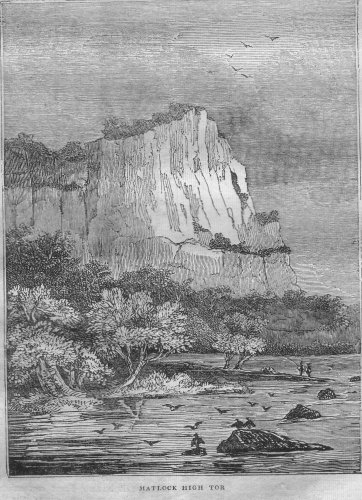
|
The bold and romantic steeps, skirted by a gorgeous
covering of wood, and rising from the margin of the
Derwent, whose waters sometimes glide majestically along,
and sometimes flow in a rapid stream over ledges and
broken masses of stone; the frequent changes of scene
occasioned by the winding of the dale, which at every step
varies the prospect by introducing new objects; the huge
rocks, in some places bare of vegetation, in others covered
with luxuriant foliage; here piled upon each other in
immense masses, there displaying their enormous fronts,
in one unbroken perpendicular mass; and the sublimity
and picturesque beauty, exhibited by the manifold
combinations of the interesting forms congregated near this
enchanting spot, can never be adequately depicted by the
powers of language.
|
Matlock includes under one name the village of
Matlock, and Matlock Bath; the village, which is of
very ancient origin, stands chiefly on the eastern
banks of the river, while the Bath, of more recent
origin, is on the western margin. The manor is
supposed to have belonged formerly to the Ferrers
family; it was afterwards part of the Duchy of
Lancaster. In 1628 it was granted to the corporation
of the city of London, and managed by trustees; at
present the rights of the manor are held in trust by
three neighbouring gentlemen.
The village of Matlock is chiefly inhabited by
persons employed in the lead-mines and in the
manufacture of cotton. The houses are principally of
stone, and at the entrance to the village is a neat
stone bridge; the church stands on a most romantic
rock at some little distance. On an eminence somewhat
higher up, called Riber Hill, are the remains of
what is supposed to be a Druidical altar; they are
called Hirst Stones.
Matlock Bath is nearly a mile and a half from the
village; but until its warm springs were brought into
notice, its situation, although beautiful and romantic,
was only occupied by a few miners' cabins. These
celebrated warm springs, which are three in number,
are not of a high temperature, the thermometer in
the bath not rising higher than 68°. The water is
much like that of the Clifton hot wells, both in
chemical and medicinal properties. The first of
these springs was discovered about the year 1698,
when the old bath was formed of wood, lined with
lead, and a few small rooms were built adjoining the
bath, forming, however, but a poor accommodation
to visitors. Some years afterwards, the property
having changed hands, two large and commodious
buildings were errected, with stables and other
conveniences, and a coach-road formed along the river-
side from Cromford. A second spring was found at
about quarter of a mile distance, and another bath
errected; and at a still later period a third, three or
four hundred yards to the east of that first discovered,
and another bath and lodging-house built; this has,
since that time, been turned into a commodious hotel;
the three buildings are called the old bath, the new
bath, and the hotel. All the hot springs issue at a
height of from about fifteen to thirty yards above the
level of the river.
At Buxton baths, which are in the same county, a
very charitable and useful custom prevails, which,
although it has no direct connexion with the baths
at Matlock, is worth noticing; it is that of collecting
the sum of one shilling from each visitor, on his
arrival, to form a fund for the poor who have to resort
to the waters. In 1572 there was a fixed rate, according
to the dignity of the visitor, and the money
raised was divided equally between the physician and
the poor bathers.
Always provyded the day of your coming thither bee
noted, before you enter the bathes, and the day of your
departure, with the country of your habitation, condition,
or calling, with the infirmityes or cause you come for, in
the regyster booke kept of the warden of the bath, or the
physition that there shall be appointed, and the benefite
you receyved, paying four pence for the recording;and every
yeoman besides, 12 pence, every gentleman 3 shillinges,
every esquior 3s. 4d, every knight 6s 8d, every lord and
baron 10s, every vicount 13s. 4d, every erle 20s., every
marques 30s, every duke 3l. 10s, every archbishop 5l,
every bishop 40s, every judge 20s, every doctour and
segeant of lawe 10s, every chancellor and utter-barrister
6s 8d, every archdeacon, pebendary, and canon, 5s,
every countes 13s 4d, every barones 10s, every lady 6s 8d,
every gentlewoman 2s, and al for the treasure of the bath.
To the use of the poor, that only for help do come thither,
the one halfe; the other to the physition for his residence.
In the midst of the beautiful scenery we have
already described, the High Tor, represented in the
engraving, is seen rearing its awful brow on the left
bank of the river; the height of this lofty rock is
upwards of 350 feet. The lower part is covered with
small trees and underwood, but the upper part, for
fifty or sixty yards, is one broad mass of naked
perpendicular rock. The fragments that have fallen
from this eminence form the bed of the river, which
flows immediately below, over a broken and disjointed
bed. After sudden and heavy rains, the impetuosity
of the current is greatly increased, and the interest
of the scene is proportionally augmented.
Immediately opposite the High Tor is a hill of less
steep ascent, but of greater elevation, called Masson
Hill, a pile of immense crags, it has received the
name of the Heights of Abram, from the resemblance
to the celebrated place of that name, near Quebec:
from this spot the view is very extensive, taking in
the whole of the dale in a bird's-eye view.
|
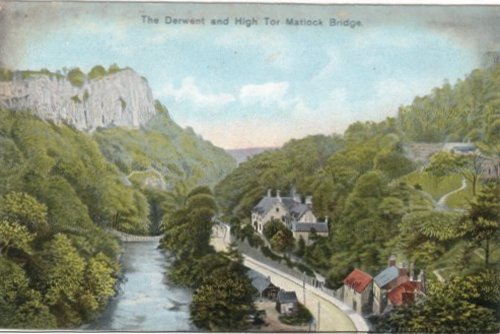
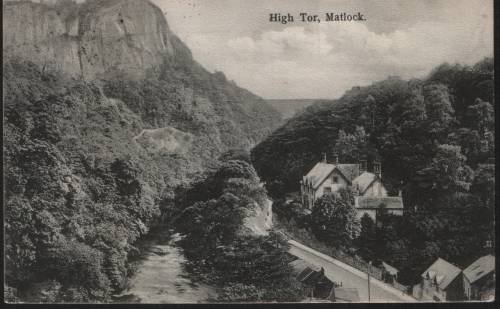
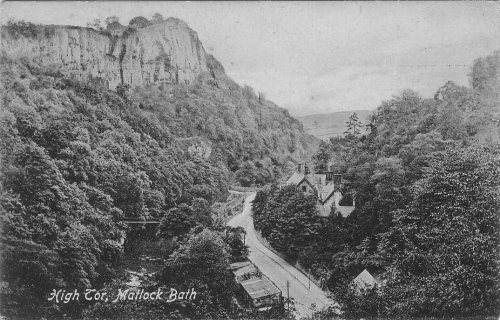
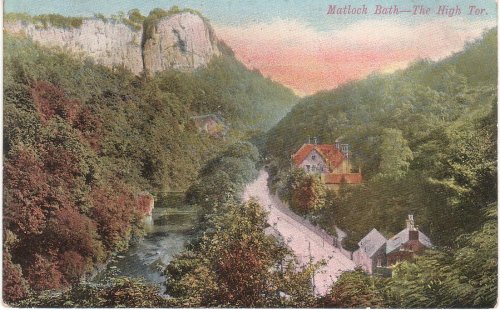
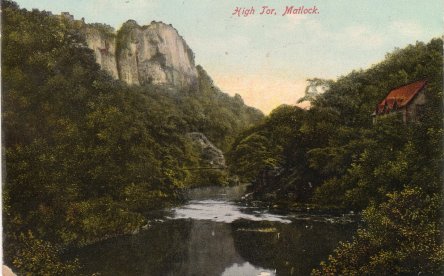
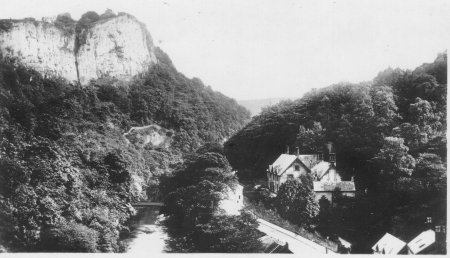
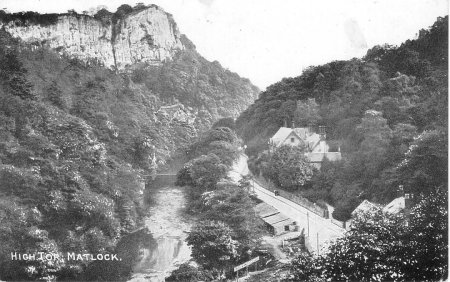
 Click on photo for enlargement (on CD only)
Have any more information about this photo?
Please e-mail the author on:
Click on photo for enlargement (on CD only)
Have any more information about this photo?
Please e-mail the author on:

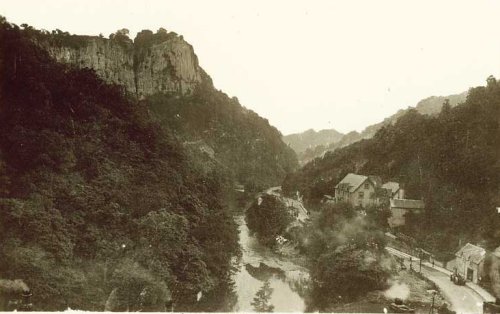 Posted 1921
Posted 1921
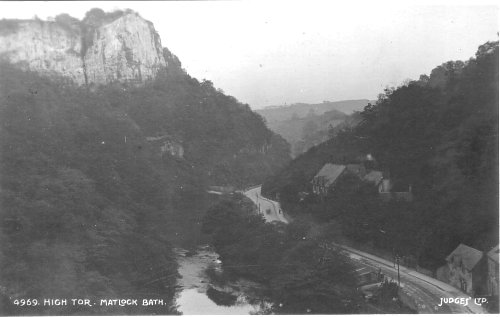 Posted 1911
Posted 1911
 Posted 1914
Posted 1914
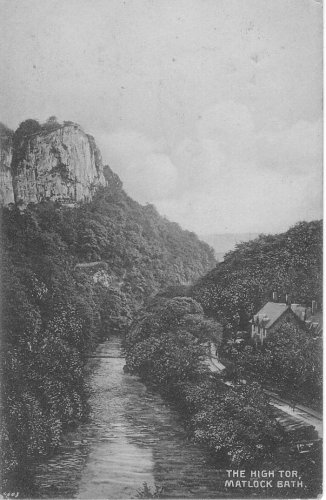 Dated Aug 1902
Dated Aug 1902
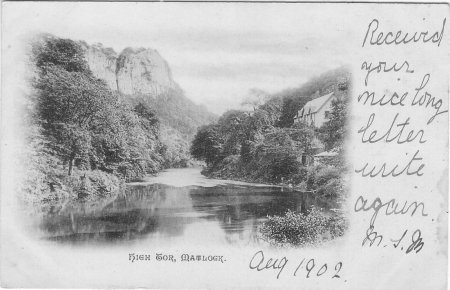
 Click on photo for enlargement (on CD only)
Have any more information about this photo?
Please e-mail the author on:
Click on photo for enlargement (on CD only)
Have any more information about this photo?
Please e-mail the author on:

 Posted 1921
Posted 1921
 Posted 1911
Posted 1911
 Posted 1914
Posted 1914
 Dated Aug 1902
Dated Aug 1902

 Click on photo for enlargement (on CD only)
Have any more information about this photo?
Please e-mail the author on:
Click on photo for enlargement (on CD only)
Have any more information about this photo?
Please e-mail the author on:

 Posted 1921
Posted 1921
 Posted 1911
Posted 1911
 Posted 1914
Posted 1914
 Dated Aug 1902
Dated Aug 1902

